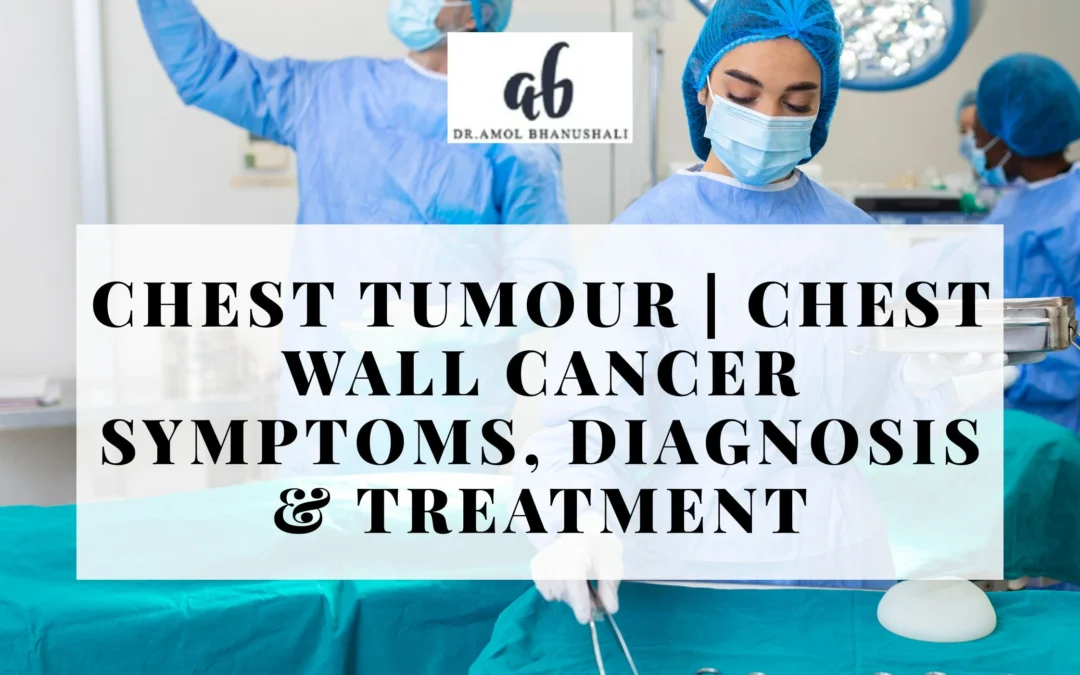Treatments and management of chest tumours, especially chest wall tumours, must be done with utmost care and technical proficiency for the same to be effective. Dr. Amol Bhanushali’s Center is the top thoracic surgery hospital in Mumbai, where chest wall cancer diagnosis, surgery, and treatment are provided. Know symptoms, test procedure, and treatment to give patients and families their best health choices.
What are Chest Wall tumours and why?
The chest wall tumours are the neoplastic connective tissue or fat masses, muscles, and bones of the chest wall.
- Most are harmful (cancer) or benign (small), ie, sarcoma and metastatic carcinoma.
- The tumour is intrathoracic or, in secondaries to other malignancies, tumours, eg, lung or breast.
- A good thoracic surgery centre in Mumbai can undoubtedly improve the diagnosis and outcomes.
Symptoms and signs of chest wall cancer: when to seek a doctor
Prompt diagnosis of chest wall cancer is essential so that optimal, effective treatment may be obtained. Look out for the following signs:
- The most common is a palpable or visible chest mass.
- Increased tumour growth may give rise to pain or tenderness in the chest, which is persistent.
- Redness, swelling, or chest wall skin tenderness must never be overlooked.
Shortness of breath or inability to cough and positional relief are also observed in chest wall tumours due to massive tumours compressing the lung or surrounding tissues.
How is a Chest Wall Tumour diagnosed at the Top Thoracic Surgery Hospital in Mumbai?
Correct treatment after correct diagnosis. International excellence centres utilise multi-mode approaches:
-
- Physical examination detects any swelling or mass first.
- Imaging studies provide information regarding the size, extent of spread, and effect on adjacent tissue of the tumour. Some of these include:
- MRI
- CT scan
- Biopsy procedures (needle or open) determine whether or not the tumour is malignant.
Specialists in a technologically advanced Mumbai thoracic surgery centre utilise molecular and genetic examinations wherever required, i.e., to formulate targeted therapy.
What Are the Different Types of Chest Wall Tumours?
Type decision-making has implications for treatment and prognosis:
Primary Bone Tumours
- Osteosarcoma – Adolescent and child malignant primary bone tumour. It is treated aggressively as it is malignant.
- Chondrosarcoma – Cartilage-type malignant neoplasm in adults. It cannot be cured by chemotherapy and radiotherapy, and hence surgical resection is the initial first line of treatment modality.
- Ewing’s Sarcoma – Most malignant during the childhood age group. Extremely malignant. The prognosis is terrible with metastasis. Along with treatment given simultaneously are surgery, radiotherapy, and chemotherapy.
- Other Primary Malignant Bone Tumours – Uncommon conditions such as malignant fibrous histiocytoma, leiomyosarcoma, plasmacytoma, etc.
Primary Soft Tissue Tumours
- Desmoid Tumours ( Aggressive Fibromatosis ) – Locally aggressive yet benign and tend to recur after surgery (e.g., thoracotomy).
- Benign Soft Tissue Neoplasms – Lipomas, fibromas, neurofibromas and elastofibroma dorsi. They are symptomatic and slow-growing due to size or location.
Secondary (Metastatic or Locally Invasive) Tumours
- Secondary Malignancies – Invasive chest wall cancers from adjacent malignancies such as breast or lung carcinoma, or metastases to the chest wall from other remote primaries.
Multidisciplinary Treatment Modalities for Thoracic Wall Cancer
Multidisciplinary treatment modalities for thoracic wall cancer include:
1. Robotic or Video Assisted Thoracoscopic Surgery (VATS)
VATS and robot-assisted surgery both employ the use of small incisions, camera and fine instruments in removing tumours with minimal trauma, pain and rehabilitation compared to conventional open surgery.
2. Advanced Imaging Integration & Surgical Precision
- Emerging Imaging Technologies: CT, MRI, and intraoperative visualisation allow precise resection of the tumour and contiguous healthy tissue.
- Augmented Reality & Navigation Systems: AR overlays permit surgeons to see internal anatomy, enhance accuracy, and minimise invasiveness.
Surgical Resection and Reconstruction
- En-Bloc Tumour Resection: Tumour resection with the included adjacent ribs, muscle, or organs provides clean margins, which are required for multidisciplinary planning.
- Oncoplastic Reconstruction Modalities: Biological or synthetic mesh/muscle flaps or meshes reconstruct chest wall function and integrity.
New Biomaterials and Regenerative Therapies
Biodegradable Meshes & Biological Implants
Temporary support devices biologically enable tissue regeneration with fewer long-term side effects.
Tissue Engineering & Stem Cell Therapy
Lab-cultured stem cells and tissues speed up recovery and functional recovery.
Adjuvant and Intraoperative Therapies
- IORT through New Radiation Technologies supports high-dose intraoperative delivery.
- HITOC provides hot chemo in the treatment of residual disease.
- Thermochemoradiation & Radiosensitizers provide optimal control of the tumour in advanced-stage disease.
Post-Operative Rehabilitation and Care
Systematic Multidisciplinary Observations and Personalised Pain Management ensure optimal recovery, early complication detection, and quality of life guarantee.
Conclusion
Chest wall tumours must be assessed by experienced hands, diagnosed at the right time, and treated with caution to derive the maximum benefit from them. Dr. Amol Bhanushali’s Center, the finest thoracic surgical clinic in Mumbai, offers the finest chest wall cancer treatment with technology, expertise, and empathy. For symptoms or a second opinion, come to Dr. Amol Bhanushali’s Center, where you get international standards of care and patient care so you can live safer and healthier lives.
FAQs
- How is a chest tumour diagnosed?
Chest tumours are detected by clinical examination, imaging scans such as X-ray or CT scan, and diagnosed by biopsy.
- Do you surgically resect chest tumours?
Yes, depending upon their size, type, and location, chest tumours usually are surgically removed and may include surgical reconstruction in conjunction.
- What would lead me to realise I have cancer in my chest?
Suspected cancer is due to a lump symptom, chronic chest pain, swelling, or dyspnea, preceded by a visit to a physician for an attempt at excluding cancer.

